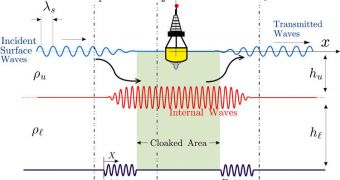Scientist Mohammad-Reza Alam predicts that it may be possible to create an invisibility cloak capable of concealing ships, oil platforms, and other man-made structures, from the fury of rough seas. This is the first time such a technique has been proposed.
Creating such a scenario is entirely different from using metamaterials to create invisibility cloaks capable of manipulating photons. The latter are already under development, and steady progress is being made on several fronts.
But concealing vessels from the waves is an entirely different situation. The technique involves altering the sea floor itself, say Alam, who is a fluid mechanics expert at the University of California in Berkeley (UCB).
He explains that invisibility cloaks for light work by deflecting the paths of photons via metamaterial, literally bending light waves around an object, and then allowing them to flow through to the other side. For an outside observer, the object being concealed appears to simply vanish.
The theory under which these devices are being developed is called transformation optics. Its most important component is a material that exhibits precisely-tuned optical properties. Alam proposes a different method for achieving the same objective in the water.
He believes that buoys and other floating structures can be kept safe from waves rippling across the surface of seas and oceans. This could be extremely useful for oil rigs working in harsh conditions, such as in the North Sea.
Alam explains that water tends to form two layers in nature – a colder, denser one at depth, and a warmer, less dense one at the surface. Waves are equally capable of moving at the surface of a body of water as they are of moving between the two layers.
An invisibility cloak for the seas would essentially turn surface waves into interface waves when the former approach the protected structure, allow them to pass harmlessly underneath, and then reconverted them to surface waves once they've passed.
The main difference between the surface waves and the interfacial waves is that – for the same frequency of oscillation – the latter travel slower, and at shorter wavelengths, than the former.
Details of the proposal appear in the latest online issue of the journal Physical Review Letters, Science Now reports.
“This thing would work, I think, to protect offshore structure. I think it has a lot of potential,” comments University of Michigan in Ann Arbor fluid mechanics expert, Marc Perlin, who was not a part of the study.

 14 DAY TRIAL //
14 DAY TRIAL //